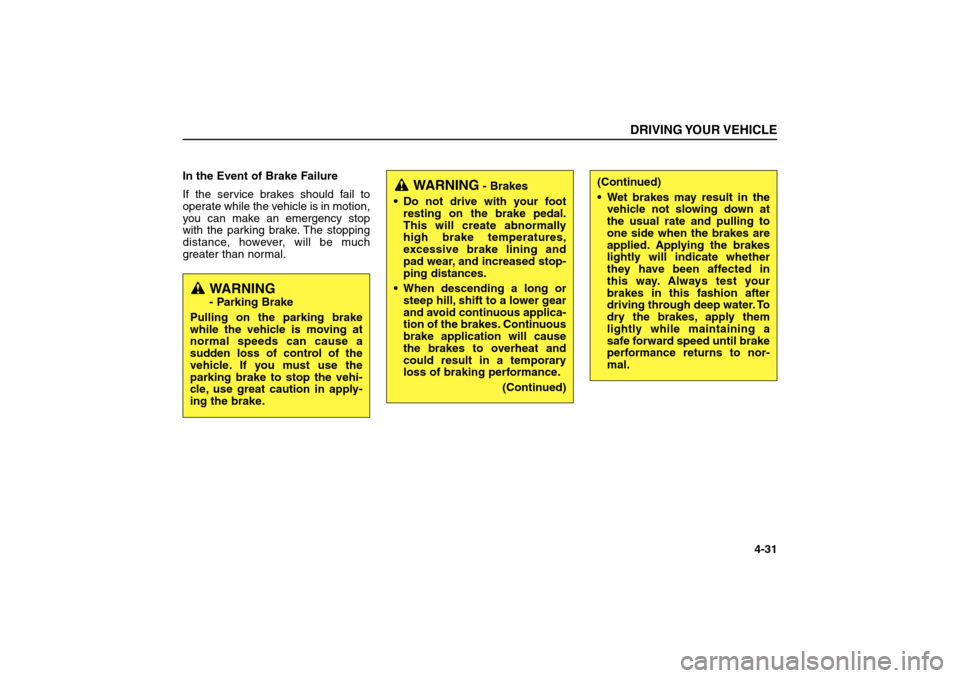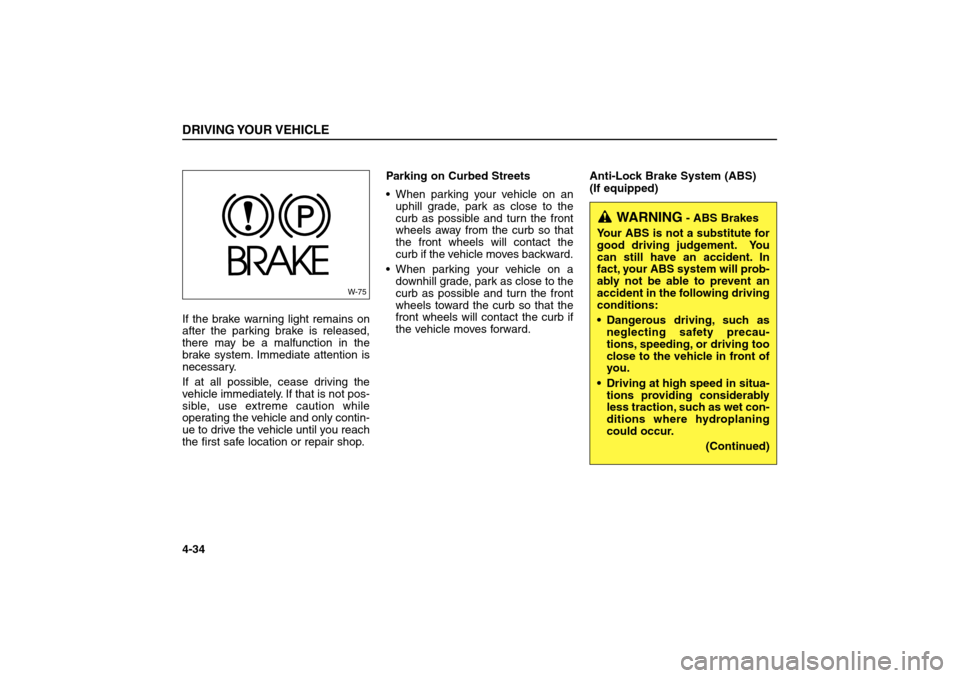Page 115 of 312

Transmission ranges
P (Park)
This position locks the transmission
and prevents the front wheels from
rotating. Always come to a complete
stop before shifting into this position.
R (Reverse)
Use this position for backing-up the
vehicle.N (Neutral)
The wheels and transmission are not
locked. The vehicle will roll freely
even on the slightest incline unless
the parking brake or service brakes
are applied.
D (Drive)
This is the normal forward driving
position. The transmission will auto-
matically shift through a 5th gear
sequence, providing the best econo-
my and power.
For extra power when passing anoth-
er vehicle or climbing grades,
depress the accelerator fully, at which
time the transmission will automati-
cally downshift to the next lower gear.
DRIVING YOUR VEHICLE
4-17
CAUTION
The transmission may be dam-
aged if you shift into P (Park)
while the vehicle is in motion.
CAUTION
Always come to a complete
stop before shifting into or out
of R (Reverse); you may dam-
age transmission if you shift
into R while the vehicle is in
motion.
WARNING
Shifting into P (Park) while the
vehicle is in motion will cause
the drive wheels to lock and
you will lose control of the
vehicle.
Always make sure the shift
lever is latched in the P (Park)
position so that it cannot be
moved unless the lock release
button is depressed.
Never leave a child unat-
tached in a vehicle.
BL-ENG (CAN)-4.qxd 7/28/05 5:55 PM Page 17
Page 129 of 312

In the Event of Brake Failure
If the service brakes should fail to
operate while the vehicle is in motion,
you can make an emergency stop
with the parking brake. The stopping
distance, however, will be much
greater than normal.
DRIVING YOUR VEHICLE
4-31
WARNING- Parking Brake
Pulling on the parking brake
while the vehicle is moving at
normal speeds can cause a
sudden loss of control of the
vehicle. If you must use the
parking brake to stop the vehi-
cle, use great caution in apply-
ing the brake.
WARNING
- Brakes
Do not drive with your foot
resting on the brake pedal.
This will create abnormally
high brake temperatures,
excessive brake lining and
pad wear, and increased stop-
ping distances.
When descending a long or
steep hill, shift to a lower gear
and avoid continuous applica-
tion of the brakes. Continuous
brake application will cause
the brakes to overheat and
could result in a temporary
loss of braking performance.
(Continued)
(Continued)
Wet brakes may result in the
vehicle not slowing down at
the usual rate and pulling to
one side when the brakes are
applied. Applying the brakes
lightly will indicate whether
they have been affected in
this way. Always test your
brakes in this fashion after
driving through deep water. To
dry the brakes, apply them
lightly while maintaining a
safe forward speed until brake
performance returns to nor-
mal.
BL-ENG (CAN)-4.qxd 7/28/05 5:55 PM Page 31
Page 130 of 312

Disc Brake Wear Indicators
Your vehicle has disc brakes.
When your brake pads are worn and
it’s time for new pads, you will hear a
high-pitched warning sound from
your front brakes. You may hear this
sound come and go or it may occur
whenever you depress the brake
pedal.
Please remember that some driving
conditions or climates may cause a
brake squeal when you first apply (or
lightly apply) the brakes. This is nor-
mal and does not indicate a problem
with your brakes.Parking Brake
To set the parking brake, pull the
parking brake handle fully and firmly
upward while applying the service
brake.DRIVING YOUR VEHICLE4-32
S2BLC302B
WARNING
- Brake Wear
This brake wear warning sound
means your vehicle needs serv-
ice. If you ignore this audible
warning, you will eventually
lose braking performance,
which could lead to a serious
accident.
✽ ✽
NOTICETo avoid costly brake repairs, do
not continue to drive with worn
brake pads. Always replace brake
pads or linings as a complete front
or rear axle sets.
CAUTION
Always replace brake pads as
complete front or rear axle sets.
BL-ENG (CAN)-4.qxd 7/28/05 5:55 PM Page 32
Page 131 of 312
To release the parking brake, pull the
handle up slightly and push the
release button. Then lower the handle
to the released position while holding
the button in.Check the brake warning light each
time you start the engine. This warn-
ing will be illuminated when the
engine is running and the parking
brake is set.
Before driving, be sure the parking
brake is fully released and the brake
warning light is off.
DRIVING YOUR VEHICLE
4-33
S2BLC302C
WARNING
To prevent unintentional move-
ment when stopped and leaving
the vehicle, do not use the
gearshift lever in place of the
parking brake. Set the parking
brake AND make sure the
gearshift lever is securely posi-
tioned in 1st (First) gear or R
(Reverse) for manual transmis-
sion equipped vehicles and in P
(Park) for automatic transmis-
sion equipped vehicles.
BL-ENG (CAN)-4.qxd 7/28/05 5:55 PM Page 33
Page 132 of 312

If the brake warning light remains on
after the parking brake is released,
there may be a malfunction in the
brake system. Immediate attention is
necessary.
If at all possible, cease driving the
vehicle immediately. If that is not pos-
sible, use extreme caution while
operating the vehicle and only contin-
ue to drive the vehicle until you reach
the first safe location or repair shop.Parking on Curbed Streets
When parking your vehicle on an
uphill grade, park as close to the
curb as possible and turn the front
wheels away from the curb so that
the front wheels will contact the
curb if the vehicle moves backward.
When parking your vehicle on a
downhill grade, park as close to the
curb as possible and turn the front
wheels toward the curb so that the
front wheels will contact the curb if
the vehicle moves forward.Anti-Lock Brake System (ABS)
(If equipped)DRIVING YOUR VEHICLE4-34
WARNING
- ABS Brakes
Your ABS is not a substitute for
good driving judgement. You
can still have an accident. In
fact, your ABS system will prob-
ably not be able to prevent an
accident in the following driving
conditions:
Dangerous driving, such as
neglecting safety precau-
tions, speeding, or driving too
close to the vehicle in front of
you.
Driving at high speed in situa-
tions providing considerably
less traction, such as wet con-
ditions where hydroplaning
could occur.
(Continued)
W-75
BL-ENG (CAN)-4.qxd 7/28/05 5:55 PM Page 34
Page 134 of 312

DRIVING YOUR VEHICLE4-36
✽ ✽
NOTICEWhen you jump start your vehicle
because of a discharged battery, the
engine may not run as smoothly
and the ABS warning light may
blink at the same time. This hap-
pens because of the low battery
voltage. It does not mean your ABS
is malfunctioning.
Do not pump your brakes!
Have the battery recharged
before driving the vehicle.
✽ ✽
NOTICE If the ABS warning light is on and
stays on, you may have a problem
with the ABS system. In this case,
however, your regular brakes will
work normally.
The ABS warning light will stay
on for 2-3 seconds after the
engine starts. During that time,
the ABS will go through self-diag-
nosis and the light will go off if
everything is normal. If the light
stays on, you may have a problem
with your ABS system. Contact
an authorized Kia dealer as soon
as possible.
✽ ✽
NOTICE When you drive on a road having
poor traction, such as an icy road,
and operate your brakes continu-
ously, the ABS will be active con-
tinuously and the ABS warning
light may illuminate. Pull your
car over to a safe place and stop
the engine.
Restart the engine. If the ABS
warning light is off, then your
ABS system is normal.
Otherwise, you may have a prob-
lem with the ABS. Contact an
authorized Kia dealer as soon as
possible.
BL-ENG (CAN)-4.qxd 7/28/05 5:55 PM Page 36
Page 139 of 312
DRIVING YOUR VEHICLE
4-41
ABS
CHECK
4WD
LOW
H
C
F
E
BRAKE
0 1 234567
8
0
0 10 203040506070
80
90
100
110
120
130
20406080100120
140
160
180
200
220
1000rpm
CRUISE
km/hMPH
IMMO
1. Tachometer
2. Turn signal indicators
3. Speedometer
4. Engine temperature gauge
5. Warning and indicator lights
6. Tripmeter / Odometer
7. Trip meter reset button
8. Fuel gauge
1
2
3
2
4
5
6
7
8
5
5BLD401
INSTRUMENT CLUSTER (MANUAL TRANSMISSION)
BL-ENG (CAN)-4.qxd 7/28/05 5:55 PM Page 41
Page 140 of 312
DRIVING YOUR VEHICLE4-42
ABS
CHECK
O/D
OFF4WD
LOW
PN R
D
2
L
H
C
F
E
BRAKE
0 1 234567
8
0
0 10 203040506070
80
90
100
110
120
130
20406080100120
140
160
180
200
220
1000rpm
CRUISE
km/hMPH
IMMO
1. Tachometer
2. Turn signal indicators
3. Speedometer
4. Engine temperature gauge
5. Warning and indicator lights
6. Tripmeter / Odometer
7. Trip meter reset button
8. Shift position indicator
9. Fuel gauge
1
2
3
2
4
5BLD402/5BLD403
INSTRUMENT CLUSTER (AUTOMATIC TRANSMISSION)
5
6
7
9
8
5
�30-40LEi�A5SR1
BL-ENG (CAN)-4.qxd 7/28/05 5:55 PM Page 42